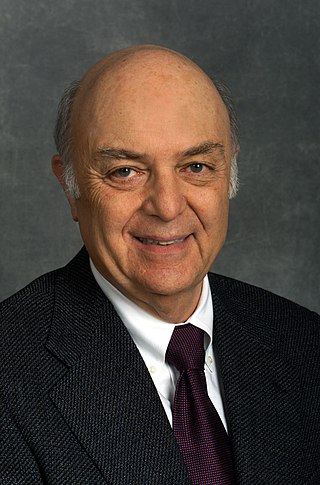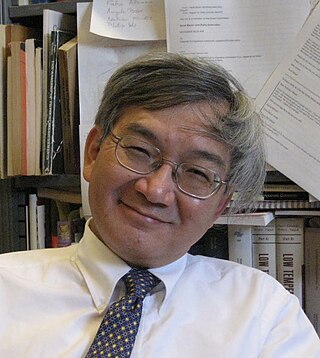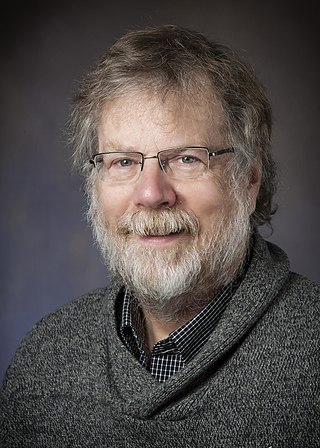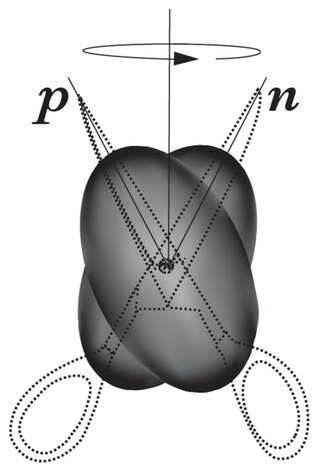Superfluid helium-4 is the superfluid form of helium-4, an isotope of the element helium. A superfluid is a state of matter in which matter behaves like a fluid with zero viscosity. The substance, which resembles other liquids such as helium I, flows without friction past any surface, which allows it to continue to circulate over obstructions and through pores in containers which hold it, subject only to its own inertia.
Resolved sideband cooling is a laser cooling technique allowing cooling of tightly bound atoms and ions beyond the Doppler cooling limit, potentially to their motional ground state. Aside from the curiosity of having a particle at zero point energy, such preparation of a particle in a definite state with high probability (initialization) is an essential part of state manipulation experiments in quantum optics and quantum computing.
The λ (lambda) universality class is a group in condensed matter physics. It regroups several systems possessing strong analogies, namely, superfluids, superconductors and smectics. All these systems are expected to belong to the same universality class for the thermodynamic critical properties of the phase transition. While these systems are quite different at the first glance, they all are described by similar formalisms and their typical phase diagrams are identical.

Spin-density wave (SDW) and charge-density wave (CDW) are names for two similar low-energy ordered states of solids. Both these states occur at low temperature in anisotropic, low-dimensional materials or in metals that have high densities of states at the Fermi level . Other low-temperature ground states that occur in such materials are superconductivity, ferromagnetism and antiferromagnetism. The transition to the ordered states is driven by the condensation energy which is approximately where is the magnitude of the energy gap opened by the transition.
Jozef T. Devreese was a Belgian scientist, with a long career in condensed matter physics. He was professor emeritus of theoretical physics at the University of Antwerp. He died on November 1, 2023.
In statistical physics, directed percolation (DP) refers to a class of models that mimic filtering of fluids through porous materials along a given direction, due to the effect of gravity. Varying the microscopic connectivity of the pores, these models display a phase transition from a macroscopically permeable (percolating) to an impermeable (non-percolating) state. Directed percolation is also used as a simple model for epidemic spreading with a transition between survival and extinction of the disease depending on the infection rate.

Marvin Lou Cohen is an American–Canadian theoretical physicist. He is a physics professor at the University of California, Berkeley. Cohen is a leading expert in the field of condensed matter physics. He is widely known for his seminal work on the electronic structure of solids.
Picosecond ultrasonics is a type of ultrasonics that uses ultra-high frequency ultrasound generated by ultrashort light pulses. It is a non-destructive technique in which picosecond acoustic pulses penetrate into thin films or nanostructures to reveal internal features such as film thickness as well as cracks, delaminations and voids. It can also be used to probe liquids. The technique is also referred to as picosecond laser ultrasonics or laser picosecond acoustics.
DP is a free software package for physicists implementing ab initio linear-response TDDFT in frequency-reciprocal space and on a plane wave basis set. It allows to calculate both dielectric spectra, such as EELS, IXSS and CIXS, and also optical spectra, e.g. optical absorption, reflectivity, refraction index. The systems range from periodic/crystalline solids, to surfaces, clusters, molecules and atoms made of insulators, semiconductors and metal elements. It implements the RPA, the TDLDA or ALDA plus other non-local approximations, including or neglecting local-field effects. It is distributed under the scientific software open-source academic for free license.

Moses Hung-Wai Chan is a Chinese-American physicist who is Evan Pugh Professor at Pennsylvania State University. He is an alumnus of Bridgewater College and Cornell University, where he earned his Ph.D. in 1974 and was a postdoctoral associate at Duke University. He has been a professor at Penn State's University Park Campus since 1979.
The hexatic phase is a state of matter that is between the solid and the isotropic liquid phases in two dimensional systems of particles. It is characterized by two order parameters: a short-range positional and a quasi-long-range orientational (sixfold) order. More generally, a hexatic is any phase that contains sixfold orientational order, in analogy with the nematic phase.

Xiao-Gang Wen is a Chinese-American physicist. He is a Cecil and Ida Green Professor of Physics at the Massachusetts Institute of Technology and Distinguished Visiting Research Chair at the Perimeter Institute for Theoretical Physics. His expertise is in condensed matter theory in strongly correlated electronic systems. In Oct. 2016, he was awarded the Oliver E. Buckley Condensed Matter Prize.

David Matthew Ceperley is a theoretical physicist in the physics department at the University of Illinois Urbana-Champaign or UIUC. He is a world expert in the area of Quantum Monte Carlo computations, a method of calculation that is generally recognised to provide accurate quantitative results for many-body problems described by quantum mechanics.

David R. Nelson is an American physicist, and Arthur K. Solomon Professor of Biophysics, at Harvard University.
Searches for Lorentz violation involving photons provide one possible test of relativity. Examples range from modern versions of the classic Michelson–Morley experiment that utilize highly stable electromagnetic resonant cavities to searches for tiny deviations from c in the speed of light emitted by distant astrophysical sources. Due to the extreme distances involved, astrophysical studies have achieved sensitivities on the order of parts in 1038.

Scissors Modes are collective excitations in which two particle systems move with respect to each other conserving their shape. For the first time they were predicted to occur in deformed atomic nuclei by N. LoIudice and F. Palumbo, who used a semiclassical Two Rotor Model, whose solution required a realization of the O(4) algebra that was not known in mathematics. In this model protons and neutrons were assumed to form two interacting rotors to be identified with the blades of scissors. Their relative motion (Fig.1) generates a magnetic dipole moment whose coupling with the electromagnetic field provides the signature of the mode.
Richard Magee Osgood Jr. was an American applied and pure physicist. He was Higgins Professor of Electrical Engineering and Applied Physics at Columbia University.
Photo-reflectance is an optical technique for investigating the material and electronic properties of thin films. Photo-reflectance measures the change in reflectivity of a sample in response to the application of an amplitude modulated light beam. In general, a photo-reflectometer consists of an intensity modulated "pump" light beam used to modulate the reflectivity of the sample, a second "probe" light beam used to measure the reflectance of the sample, an optical system for directing the pump and probe beams to the sample, and for directing the reflected probe light onto a photodetector, and a signal processor to record the differential reflectance. The pump light is typically modulated at a known frequency so that a lock-in amplifier may be used to suppress unwanted noise, resulting in the ability to detect reflectance changes at the ppm level.
Bose–Einstein condensation of polaritons is a growing field in semiconductor optics research, which exhibits spontaneous coherence similar to a laser, but through a different mechanism. A continuous transition from polariton condensation to lasing can be made similar to that of the crossover from a Bose–Einstein condensate to a BCS state in the context of Fermi gases. Polariton condensation is sometimes called “lasing without inversion”.

An electron-on-helium qubit is a quantum bit for which the orthonormal basis states |0⟩ and |1⟩ are defined by quantized motional states or alternatively the spin states of an electron trapped above the surface of liquid helium. The electron-on-helium qubit was proposed as the basic element for building quantum computers with electrons on helium by Platzman and Dykman in 1999.










